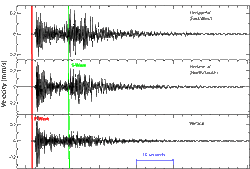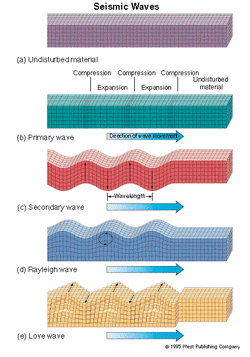An earthquake wave is the energy from an earthquake that is spread outward in all directions from the focus. The study of Earthquake waves is called seismology. Seismographs are instruments that record earthquake waves and seisomograms are the readings produced by a seismograph. A seismogram shows all three types of waves, which are surface, P, and S waves. There are two main types of seismic waves produced by an earthquake - surface waves and body waves.
Surface waves are seismic waves that travel along Earth's surface. Surface waves travel the ground and cause anything resting upon it to move. Surface waves move in up-and-down and side-to-side motions. The side-to-side motions are damaging to the foundations of buildings. These movements make surface waves the most destructive earthquake waves.
Body waves are either classified as P waves or S waves, depending on how they travel through Earthis interior materials. P waves, also known as compression waves, are push-pull waves. They compress and expand rocks in the direction that the waves travel. S waves shake particles at right angles to their direction of travel. S waves are transverse waves and temporarily change the shape of the material of which they penetrate. S waves are not transmitted through either gases or liquids.
P waves arrive first, S waves second, and surface waves last. These waves arrive at different times becaues they travel at different speeds. P and S waves are useful in providing a way to locate the epiceearthquake. nter of an
Surface waves are seismic waves that travel along Earth's surface. Surface waves travel the ground and cause anything resting upon it to move. Surface waves move in up-and-down and side-to-side motions. The side-to-side motions are damaging to the foundations of buildings. These movements make surface waves the most destructive earthquake waves.
Body waves are either classified as P waves or S waves, depending on how they travel through Earthis interior materials. P waves, also known as compression waves, are push-pull waves. They compress and expand rocks in the direction that the waves travel. S waves shake particles at right angles to their direction of travel. S waves are transverse waves and temporarily change the shape of the material of which they penetrate. S waves are not transmitted through either gases or liquids.
P waves arrive first, S waves second, and surface waves last. These waves arrive at different times becaues they travel at different speeds. P and S waves are useful in providing a way to locate the epiceearthquake. nter of an


